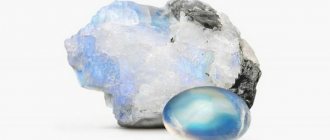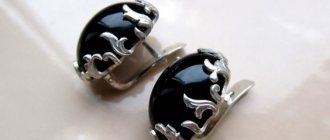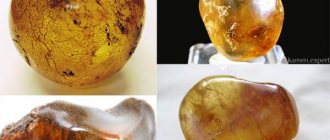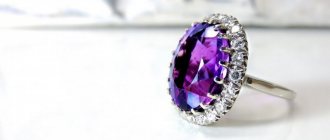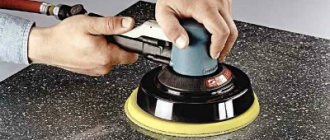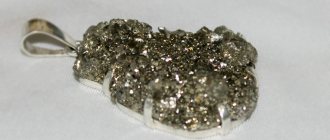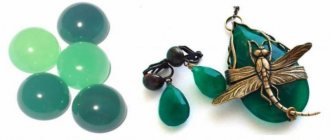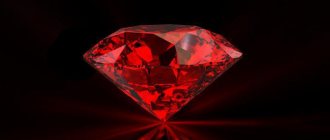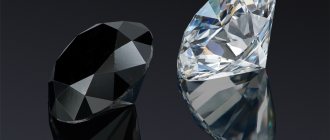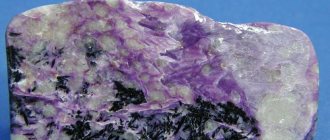If you decide to purchase a stone countertop, you may be pleasantly surprised by the variety of types of stone. And it can also confuse you. The total range of natural stone reaches many hundreds of species. Below we will look at the main criteria by which you should choose stone for countertops. And using the filters in the catalog, you can select types of stone that suit you in color and other characteristics.
Water absorption
An example of how marble has absorbed dirt in the place where a flower pot stands.
Water absorption is the ability of a stone to absorb moisture.
When it freezes, it expands and microcracks appear in the material. Over time, they increase for the same reason - and the stone gradually collapses. Therefore, for finishing facades, plinths, and entrance groups, it is better to use granite, limestone or dense sandstone - materials with a low water absorption coefficient. Marble or travertine are materials that absorb moisture; the surface must be additionally treated with a special protective compound. If this is not done, stains and stains will form on the stone, which spoil the appearance of both the stone and the building as a whole.
It's the same story with the interior decoration. Only in this case, you need to take into account that along with water, dirt and dyes can penetrate into the stone - coffee, tea, wine, stains that are almost impossible to remove from marble, sandstone or travertine, and the expensive finish will be irrevocably damaged.
With indoor walls, everything is much simpler: you can ignore water absorption rates and use any stone that you like. The exception is the bathroom, kitchen, sauna or swimming pool, where there is a lot of moisture and there is a risk that efflorescence or traces of dirt will appear on the walls. It is worth selecting stone for these premises taking into account the operating conditions.
An example of dirty stains on a marble wall. It is almost impossible to remove them!
How to choose a talisman stone
Each gem affects certain areas of human life. It is better to choose a mineral based on your own priorities and character traits. The following are considered universal stones for amulets:
- emerald;
- cat's eye;
- agate;
- opal;
- malachite.
These gems symbolize good luck and success. They will help a person climb the career ladder. Having a gem with you, you will be able to win people over, and it will be easier for you to achieve your goals. Stones can serve as amulets, warding off troubles and misfortunes.
It is best to choose stones personally. This way their magical properties will fully manifest themselves. They will not have negative side effects. You can choose a talisman that improves the areas that interest you most, be it luck in money or love.
To watch a program about lucky stones:
Owner's temperament
It is advisable to look for a talisman in accordance with the element under which the person was born:
- For people of the fire element, it is better to choose transparent gems in muted warm tones.
- The air is protected by translucent minerals of white, green, yellow, and blue colors. It is better if the tone is gentle, pastel.
- Gems of dark, dirty shades are suitable for the earthly element. The stones must be colored evenly and opaque.
- For people born under the cover of the water element, blue and greenish gems are considered the best talismans. The presence of luminescence is welcome.
There are some nuances in choosing an amulet related to gender characteristics:
- Stones of bright colors or deep dark tones are suitable for men.
- Women should carry translucent minerals in light shades.
A good approach is to choose a stone based on temperament and the most pronounced character traits:
- For noisy, active individuals, garnet is suitable.
- It is better to choose sapphire for kind quiet people, distinguished by modesty and meekness.
- Hematite is suitable for disciplined and reserved people. Otherwise, he may develop straightforwardness and rudeness.
- Alexandrite gets along with any temperament, but it is necessary to wear it in combination with other stones. Otherwise, he will oppress his owner and cause melancholy.
- It is not recommended to wear topaz for people striving for success in love. It can create problems on the personal front.
Watch the webinar about which talisman gems men choose:
By zodiac sign and name
Astrology of stones and talismans will help you determine your mineral. Because the human energy field and its main features are associated with the time of birth. Each sign is asked to choose a stone from the options that suit it:
- Life-loving Aries will find their talisman among diamonds, citrine, and amber.
- Sapphire, aventurine, turquoise, agate, and quartz will help Taurus become more open and romantic.
- Gemini will be led to spiritual harmony by obsidian, jade, pearls, and malachite.
- Hematite, ruby, jasper, pearl, aquamarine, ruby are more suitable for Cancers than others.
- For Leos, tiger and cat's eyes are suitable as amulets. Like talismans - heliodor, diamond, alexandrite.
- Topaz, lapis lazuli, carnelian, chrysolite, and onyx will help Virgos in love affairs and career.
- Opal, lapis lazuli, aquamarine, topaz, and ruby will add decisiveness to Libra.
- Garnet, hematite, and carnelian will help Scorpios get rid of bad motives and thoughts.
- Ruby, amethyst, chrysolite, turquoise, topaz will allow Sagittarius to achieve success and attract good luck.
- Capricorns can become more open and successful with the help of pomegranate, ruby, agate, and carnelian.
- Garnet, sapphire, amethyst, and agate will help Aquarius in business. Stones will attract love and help you become more friendly.
- Moonstone, pearls, opal will become a reliable talisman for Pisces.
You can also select a mascot by name:
To watch a video on the topic of stones and names:
By time of year
The season in which a person was born also influences the selection of a talisman:
- Winter months - white, milky, azure, blue shades.
- Spring months – soft green, bluish shades.
- Summer months - bright shiny minerals.
- The autumn months are rich in blues, ochres, oranges, yellows, purples, and grays.
By day of the week
There are recommendations from esotericists for the days of the week:
- White tones are ideal for Monday;
- on Tuesday blue and purple shades are suitable;
- on Wednesday, take azure minerals with you;
- Lilac colors are good for Thursday;
- on Friday the best option is green;
- Saturday is good for dark stones;
- on Sunday, choose yellow or gold pieces.
Helpers for different purposes
Different rocks may be most effective in certain aspects:
- Agate, turquoise, chrysolite, opal, cat's eye, carnelian and hematite are considered powerful amulets against the evil eye and damage. They ward off danger and illness, protect against unkind looks and words, and expose lies.
- To attract love into your life, use lapis lazuli, rose quartz, ruby, tourmaline, malachite.
- Ruby, alexandrite, garnet, diamond and sapphire will help with your career and money.
- In spiritual growth and self-improvement, zircon, amethyst, emerald, and olivine are considered the best helpers.
View this post on Instagram
Posted by Sacred Space by (@sacred_space_by_jane_k) Jul 30, 2019 at 3:35 PDT
Frost resistance
Like water absorption, frost resistance is a key characteristic of stone for exterior decoration in our climatic conditions. It determines how quickly the stone will deteriorate during alternating freezing and thawing - which regularly occurs during the changing seasons.
To designate this indicator, a frost resistance grade is used - F10, F15, F25, F35, F50, F75, F100, F150, F200, F300, where F is frost resistance, and the numbers are the number of freezing and thawing cycles.
For exterior decoration, you need to choose a stone that can withstand more than 50 cycles - frost resistance index F50 and higher. Typically, it is granite, limestone or slate. When choosing a stone for interior decoration, this indicator can be ignored.
Water – birth, sensitivity, new beginning
Water is considered one of the most powerful conductors of vital energy. Its effect is most pronounced in winter, as well as at night. The cardinal direction dedicated to this element is north. This natural power is symbolized by black and all shades of blue. It appears in sinuous, spiral and wavy forms. Symbols of Water are an aquarium with fish, a fountain, a mirror or transparent glass, as well as paintings depicting rivers, seas, and the ocean.
At the mental level, this element is responsible for emotional sensitivity. Having learned to control it, you will be able to make intuitively correct decisions, which will certainly lead to financial success and prosperity. In addition, Water can give you new ideas, business plans, and bold projects. To attract her favor, the magic of blue and light blue stones is used - aquamarine, turquoise, beryl, sapphires, opals and fluorite.
An excess of this element leads to poor health, stagnation in business, apathy and passivity. You can weaken its influence by surrounding yourself with things made from amethyst, rock crystal, topaz, jade, flint, amber and jasper.
Acid resistance
Acid resistance determines changes in the structure and color of a stone when interacting with acid.
Why is it important? In cities, acidic chemicals are often used to clean streets and speed up snow melting. Acids are also formed when exhaust fumes from cars react with water. Because of this, the stone is destroyed and plaque appears on it.
An example of changes in the structure and color of a stone under the influence of the external environment.
Granite, basalt and quartzite have good acid resistance. Therefore, they are most often used in finishing the facades and plinths of buildings located in the city. Limestone is more susceptible to acids, so it is used for exterior decoration mainly in private housing construction - where the building is exposed to less acid from exhausts and street chemicals.
In some interior solutions, the acid resistance of the stone is also important. Marble is sensitive to acids, including food acids - citric and acetic. Therefore, without a special protective coating, it is not advisable to use it for kitchen countertops and sinks. Also, marble, like travertine and limestone, is destroyed by the action of hydrochloric acid, which is contained in many cleaning products.
Mineral quality assessment
Gemological examination is the study of the authenticity of stones. Product quality control occurs as follows. The first assessment is visual. A gemologist examines a mineral with a magnifying glass. During this inspection, defects are eliminated:
- chips;
- scratches;
- abrasions.
There are characteristic inclusions for each mineral. The gemologist sends the product for additional research if he finds the following signs:
- uneven coloring;
- bubbles.
The examination and assessment centers use the following devices:
- Refractometer.
- Polariscope.
- Chelsea filter.
- Jim the tester.
Using a polariscope, the extinction of the sample is determined. A gemologist will be able to immediately determine whether it is glass or mineral.
A refractometer measures the refractive index, which differs for each material. Immersion liquid is used for the study. Using a pipette, apply a few drops and cover with protective glass. Readings are taken after 30 seconds. After this, they compare it with the table data and determine which mineral was brought for evaluation.
How to distinguish natural stone from artificial? The Chelsea filter helps determine the origin of emeralds, sapphires and rubies. Some gemologists believe that the device has lost its relevance. Synthetic emeralds are difficult to distinguish even with the help of equipment.
The Jim Tester measures the thermal conductivity of a mineral.
The laboratory determines:
- authenticity;
- origin;
- presence of improvement.
The principle of stone evaluation is called the “4 C rule”. These are criteria such as weight, color, purity and quality.
Wear resistance
Wear resistance shows how easily a stone is damaged by mechanical action (impact resistance) and how quickly it wears out as a result of friction (abrasion). These indicators are critically important when choosing stone for cladding floors, stairs, and platforms.
Granite finishing of stairs and walls in an office building with high traffic.
Granite, diorite and sandstone have good wear resistance. Marble and travertine are stones with medium wear resistance, porous limestones have low wear resistance.
If you have a floor made of the “right” stone, then even if heavy objects fall on it, cracks and chips will not form on it, and the most traveled places will not differ from the rest of the space.
Travertine
Travertine is an excellent material option when performing facing work.
The color of a stone in nature can be:
• light shades of beige; • nutty; • brown; • yellow; • red.
The following work can be done from this material:
• cladding the external walls of premises, facades; • pave floor coverings; • treat walls and floors in the bathroom, sauna; • cladding fireplace portals, stairs; • decorate arches; • zone the space.
Travertine is not subject to abrasion, which is very valuable in construction. This material is also characterized by heat resistance and thermal conductivity. The stone is easy to cut, polish and grind, so it is often used when decorating the external walls of various rooms of houses. If water gets on the surface of natural stone, it does not become slippery, and this is very important during construction work in bathrooms and saunas.
Fire resistance
Fire resistance characterizes the changes in stone under the influence of high temperatures and open fire.
Marble, dolomite, onyx - types of stone with high fire resistance - do not crumble or deform when exposed to high temperatures, which is important when you decorate fireplaces, baths and other rooms with stone. They also limit the spread of fire, which can even prevent or stop a fire.
Tree – growth, creativity, development
This element is strongest in spring. In addition, it is activated in the morning, especially if you turn to the side of the world dedicated to it - the east or southeast. Symbols of the Tree are all shades and tones of green, rectangular, cylindrical and oblong shapes, indoor plants, paintings with images of forests, groves, trees, interior items carved from different types of wood, furniture made from wicker and even paper books!
This natural element controls a person’s creative abilities , his ability to express his personality in any activity. It will give you the joy of knowledge, achievement and development. In addition, this element ensures success in new endeavors. Therefore, if you feel that your work has become too routine and boring, try to bring as much Wood energy into your life as possible. Suitable talisman stones for this include emerald, malachite, moss agate, pieces of petrified wood, peridot and chrysoprase.
But be careful - the excessive presence of the elements can provoke uncontrollable changes, a lack of clear guidelines, stability and orderliness in your life. If this does happen, you can weaken the element by using products made from diamonds, alexandrites, aventurine, pyrite, tourmaline and pearls.
A few final tips
- Determine the environmental conditions - whether the stone will be exposed to temperature changes, acids and salts, friction, or contact with water.
- Consider the features and properties of the stone, and do not be guided only by its decorative properties.
- For exterior decoration in our climate, it is better to choose a stone with low water absorption and high frost resistance: granite, limestone, slate, dolomite, dense types of sandstone.
- For interior design - depending on where the stone will be laid - you also need to pay attention to the wear resistance, acid resistance and fire resistance of the material. Marble, onyx and dolomite are good for fireplaces, slate and marble for kitchens and bathrooms, granite and marble for floors.
- Keep in mind that the properties of the stone also depend on the deposit. The same characteristics of a certain type of stone mined in different regions may differ.
If you have any doubts, ask and clarify. After all, finishing with natural stone will last for a long time, which means you need to be very careful and attentive to your choice.
Marble
This stone refers to a rock that was formed under conditions of high pressure and temperature. Consists exclusively of calcite.
Basic colors of natural marble:
• grey; • yellow; • white; • red; • green; • black.
The latter colors are characteristic of silicate marble, in which the shade is influenced by the presence of coloring substances - limonite, hematite, graphite, oxidized manganese.
Marble has a distinctive pattern, which is most evident after careful polishing of the stone. If the marble surface is polished, it will lose the clarity and brightness of the pattern. To hide the pattern and lighten the overall background, the chipping technique is used.
Where it is used:
• internal laying of flooring; • creation of balusters; • facing works of walls, fireplaces, staircases, saunas; • construction of mosaics, sculptures.
The advantages of marble include its decorative properties, average hardness and density, and high heat resistance. The material can be easily machined and polished.
Among the disadvantages of the stone, its capriciousness is noted due to the frequent formation of stains and yellowing of the surface. This happens under unfavorable conditions for using marble.
Earth – peace, stability, prosperity
Earth time is called every third month of the season: February, May, August, November. This element is most pronounced during the day, and talismans that attract it should be placed in the southwestern and northeastern parts of the house. The element is symbolized by a square, horizontal rectangle, globe, ceramic, porcelain, faience and marble accessories, any images of landscapes and landscapes. Its colors are yellow and brown, as well as their shades.
The element is responsible for family well-being, mutual understanding, strengthening family ties . It helps to gain wisdom, spiritual balance, harmony. Amethysts, tiger's eye, marble, jade, topazes and rauchtopazes, amber, citrine can enhance the influence of the Earth.
But you should not overload the space with signs of this energy. Their excess suppresses activity, leads to boredom, despondency, and causeless anxiety. To ease such sensations, use olivine, moss agates, malachite, emeralds, and chrysolites.
